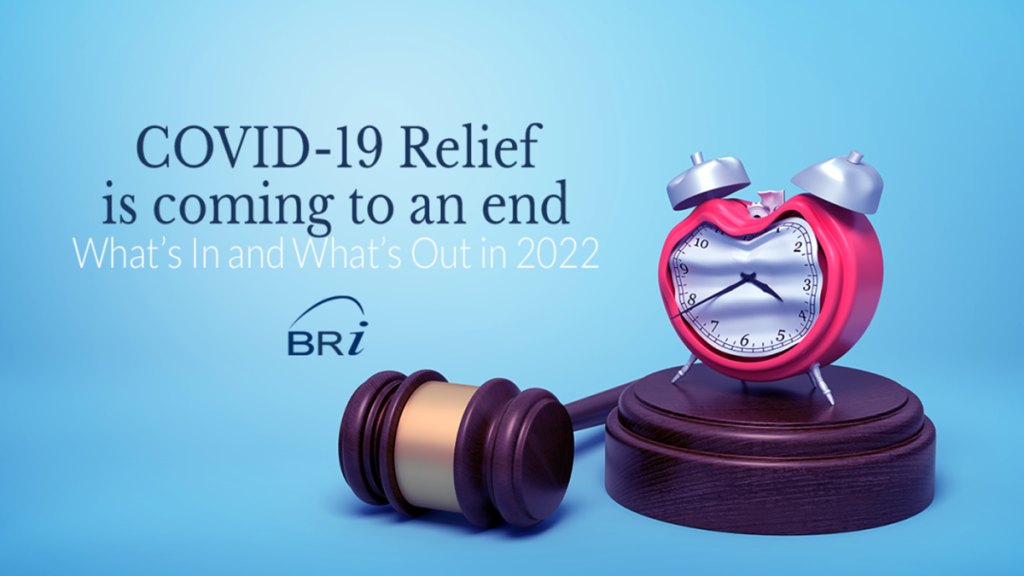Sometimes change comes roaring in with a big splash and flashing lights. But other times, change comes quietly. You have to read the fine print to even know that it is happening. This is where many Human Resources professionals find themselves these days as they try to navigate modifications to their benefit plans and the effects of new and expiring legislation.
What’s In
New Limits to FSAs, HSAs, Commuter Benefits for 2022
The IRS sets the annual limits for many benefits based on inflation factors. The IRS recently released the inflation limits for several fringe benefits. Limits for Health Savings Accounts (HSAs) were released earlier this year.
Pre-tax Account Limits for 2022
- Health Flexible Spending Account: $2,850 (Up from $2,750 in 2021)
- Health FSA Rollover: $570 (Up from $550. Temporary relief in 2021 allowed for the entire balance to rollover)
- Transportation Benefits (Mass Transit and Parking): $280/mo. (Up from $270/mo. in 2021)
Health Savings Account Limits for 2022
Individual / Self-only Coverage
- Contribution Limit: $3,650 (Up from $3,600 in 2021)
- HDHP minimum deductible: $1,400 (No change from 2021)
- HDHP maximum out of pocket: $7,050 (Up from $7,000 in 2021)
Family Coverage
- Contribution Limit: $7,300 (Up from $7,200 in 2021)
- HDHP minimum deductible: $2,800 (No change from 2021)
- HDHP maximum out of pocket: $14,100 (Up from $14,000 in 2021)
Recently Expanded Eligible Expenses
The definition of eligible medical expenses was expanded three separate times since the pandemic began. Individuals participating in Health FSAs, HSAs, and certain HRAs can now use their funds for:
- Over-the-counter drugs and medicines.
- Menstrual care Items.
- COVID-19 PPE items such as masks, hand sanitizer, and sanitizing wipes.
- At-home COVID-19 testing kits
According to the November 2021 SIGIS Eligible Product List, there are now 141,230 eligible items. SIGIS sets standards for an inventory information approval system (IIAS) that allows point-of-sale systems to easily identify eligible items.
Navigating Vaccine Requirements and Incentive Programs
The conversations and rules regarding COVID-19 vaccine mandates and incentives are complex and evolving. But, to keep it simple, many employers may be required to enforce requirements regarding tracking employee vaccination status and may be required to receive weekly testing results for any employee who is not vaccinated. While the legality of these types of orders is being challenged, employers could still be required to comply as soon as January 4, 2022. Employers can make preparations by establishing a process and beginning to collect employees’ vaccination status.
Employers looking to offer employees an incentive for receiving the COVID-19 vaccine should be aware of potential violations from the Equal Employment Opportunity Commission (EEOC). A best practice is to offer a COVID-19 incentive as an option in a broader wellness incentive.
What’s Out
Temporary Relief for Health FSAs and Dependent Care FSAs Is Coming to an End
The Consolidated Appropriations Act, 2021 included several temporary relief options for Health FSAs and Dependent Care FSAs. However, this relief only applied to the 2020 and 2021 Plan Years. As employers and participating employees begin the 2022 Plan Year on January 1, they need to be aware of a few changes.
- Prospective changes to elections will once again require a qualifying event. If permitted by the plan, participants were able to make election changes for any reason in 2020 and 2021.
- Carryover amounts cannot exceed the inflation-adjusted amounts (up to $570 for 2022). For the 2020 and 2021 Plan Years, plans were permitted to allow the carryover of the entire balance. If plan sponsors did not initially take advantage of this option, there is a small window to do so. Plans ending on 12/31/2021 can still be amended to allow funds to roll into the 2022 Plan Year.
- The maximum age for an eligible dependent for a Dependent Care FSA is defined as under 13. The temporary relief extended it to under 14.
Dependent Care FSA Limit Returns to $5,000
The Dependent Care FSA limit returns to $5,000 as of January 1, 2022. This change affects both calendar year plans and non-calendar year plans. The relief offered through the American Rescue Plan Act of 2021 (ARPA) allowed the Dependent Care FSA limit to increase to $10,500 for 2021. Without action from Congress, this limit automatically returns to $5,000 annually as of January 1, 2022.
Safe Harbor Expiring for Telehealth and Remote Care Services Covered Prior to Deductible without Affecting HSA Eligibility
To contribute to an HSA, an individual must be covered by a high deductible health plan and cannot have other coverage prior to meeting the deductible, except for preventive care. The IRS has provided temporary relief from this requirement and allowed telehealth and remote care services to be covered prior to the deductible. This temporary relief expires on December 31, 2021. It is possible that the IRS could release additional temporary relief through the designated pandemic period.
The Bottom Line
While impacts of COVID-19 are far from over, the initial turbulence caused by the pandemic has started to subside and is reflected in these legislative changes. The trend seems to shift focus back out of emergency survival mode as temporary relief ends and limits are set to return to their normal inflation-adjusted amounts. While a return to “normalcy” seems like it’s on the horizon for benefits, we still have our reading glasses on and ready to read the fine print for future legislative changes.



